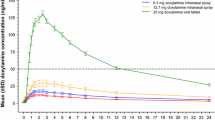Abstract
Immediate effects on sleep of 100, 200 and 300 mg 6-(3-chloro)-phenoxy-2-methyl-1-oxa-4-azospiro-[4,5]decane-3-one (CERM 3726) were studied in six healthy males. There was some sleep disturbance in two subjects with 100 and 200 mg, but only with 300 mg was there unequivocal evidence of reduced total sleep time and stage 2 sleep, together with a trend toward reduced rapid eye movement sleep. Arousal, at least as indicated by sleep studies, may be associated with the reported effect of the drug to oppose the deterioration in performance of tests of prolonged duration.
Similar content being viewed by others
References
Autret A, Minz M, Beillevaire T, Cathala HP, Schmitt H (1977) Effect of clonidine on sleep patterns in man. Eur J Clin Pharmacol 12:319–322
Caille EJ, Bassano JL, Lacoste JP, Poulain PH (1978) Étude de la molécule 3726 CERM au niveau du processus hypnique, de l'activité cérébrale en état de veille et de la disponibilité au réveil. Psychol Med 10:1823–1837
Cianchetti C, Masala C, Margoni A, Gessa GL (1980) Suppression of REM and delta sleep by apomorphine in man: A dopamine mimetic effect. Psychopharmacology 67:61–65
Everett GM (1975) A unique dopamine mimetic: Pemoline. Pharmacologist 17:227
Hartman E (1978) Effects of psychotropic drugs on sleep: The catecholamines and sleep. In: Lipton MA, Mascio A, Killam AF (eds) Psychopharmacology: A generation of progress. Raven Press, New York, pp 711–728
Nicholson AN, Stone BM (1980a) Heterocyclic amphetamine derivatives and caffeine on sleep in man. Br J Clin Pharmacol 9:195–203
Nicholson AN, Stone BM (1980b) A synthetic ACTH4–9 analogue (Organon 2766) and sleep in healthy man. Neuropharmacology 19:1245–1246
Nicholson AN, Stone BM, Jones MMC (1980) Wakefulness and reduced rapid eye movement sleep: Studies with prolintane and pemoline. Br J Clin Pharmacol 10:465–472
O'Hanlon JF, Fussler C, Sancin E, Grandjean EP (1978) Efficacy of an ACTH4–9 analogue, relative to that of a standard drug (d-amphetamine), for blocking the “vigilance decrement” in man. Cited by Pigache RM, Rigter H (1980). In: Rees LH, van Winersma Grieidanus TB (eds) Frontiers of hormone research, vol VI. Karger, Zurich
Rechtschaffen A, Kales A (1968) A manual of standardised terminology, techniques and scoring system for sleep stages of human subjects. National Institute of Health. No. 204 bis, US Government Printing Office, Bethesda, MD
Spiegel R (1979) Effects of amphetamines on performance and on polygraphic sleep parameters in man. Adv Biosci 21:189–201
Author information
Authors and Affiliations
Rights and permissions
About this article
Cite this article
Nicholson, A.N., Stone, B.M. 6-(3-Chloro)-phenoxy-2-methyl-1-oxa-4-azospiro-[4,5]decane-3-one (CERM 3726) and sleep of healthy men. Psychopharmacology 76, 157–159 (1982). https://doi.org/10.1007/BF00435270
Received:
Issue Date:
DOI: https://doi.org/10.1007/BF00435270




